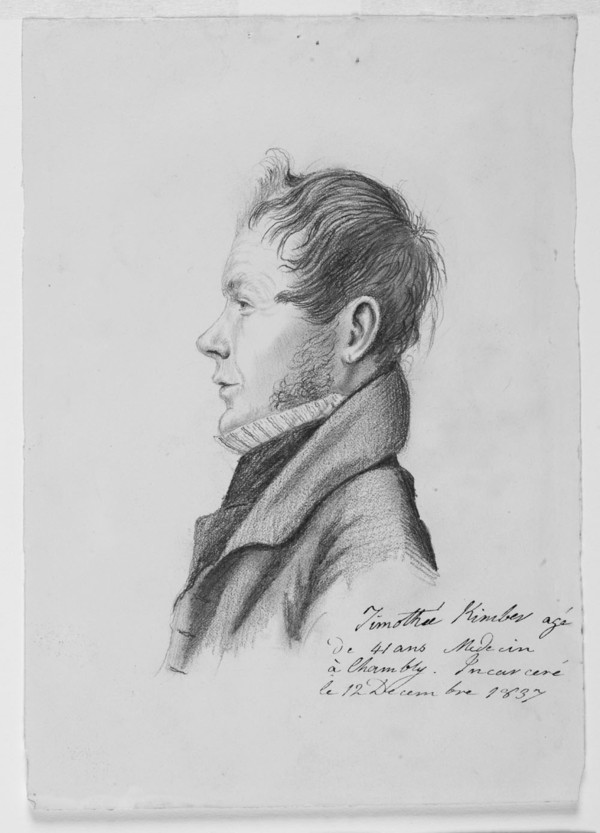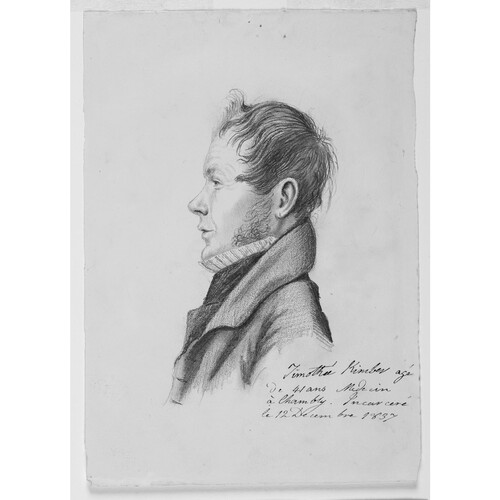KIMBER, TIMOTHÉE, physician, distiller, and Patriote; b. 11 Feb. 1797 at Quebec, son of Joseph Kimber and Josette Dabin; d. 6 Feb. 1852 in Chambly, Lower Canada.
Joseph-Antoine Jékimbert, a forebear of the Jékimberts or Kimbers, was a gardener originally from Aix-la-Chapelle (Federal Republic of Germany) who is thought to have come to New France as a soldier in the colonial regulars between 1750 and 1753. Some 12 or 15 years after his arrival, he adopted the spelling Kimbert or Kimber to give a more French form to his name. His son Joseph, the father of Timothée, served in Quebec’s militia battalion in the winter of 1775–76 and probably helped repel the American invasion. He subsequently worked as a gardener in the town, like his father. In 1780 he married at Quebec.
Timothée Kimber was the eleventh in a family of twelve children. Despite his humble origin, it was possible to send him to school. He began classical studies at the Petit Séminaire de Montréal in 1806 and did not complete them until 1816. At the end of his schooling he remained in Montreal for a few years and decided to train as a doctor there. According to Laurent-Olivier David*, John Douglas Borthwick, and Ægidius Fauteux*, in 1817 or 1818 Kimber’s attention was attracted by young Jean-Olivier Chénier* – later the hero of Saint-Eustache – and he took the boy under his wing, making himself responsible for educating him. Kimber is believed to have gone to Europe in 1819, and the following year he studied medicine in Paris. No doubt he enjoyed being in France, where, as he attended courses, he probably absorbed the revolutionary philosophy of 1789.
Kimber returned to Lower Canada in 1821 and on 22 June was licensed to practise medicine, surgery, and obstetrics in the colony. He took up residence at Chambly, near Montreal, and soon opened an office there. On 12 Nov. 1822, at Chambly, he married Emmélie Boileau, daughter of René Boileau, a former member for Kent in the House of Assembly. By his marriage Kimber entered one of the old and distinguished French Canadian families in the Richelieu valley. Like his cousin René-Joseph Kimber of Trois-Rivières, he was a skilful doctor and thus soon acquired a large practice. Because of his knowledge and ability he was also called upon to supervise the training of a number of medical practitioners, one of whom was Chénier. In 1831 Kimber was elected to the board of examiners for the district of Montreal, along with Robert Nelson*, Jacques Labrie*, and Wolfred Nelson*, among others. During the cholera epidemic the following year he was appointed a member of the Chambly board of health, which was chaired by the co-seigneur of Chambly, Samuel Hatt, a legislative councillor.
Kimber greatly admired Louis-Joseph Papineau*, the leader of the Patriote party. He also formed a friendship with Wolfred Nelson, one of Papineau’s principal lieutenants in the Montreal region. Indeed, around 1830 he went into partnership with him to set up a distillery at Saint-Denis, on the Richelieu, which was burned down a few days after the battle in that village in November 1837. In 1834 Kimber was one of the principal Patriotes in Chambly County, and participated in the meeting held there that year which took a stand in favour of the 92 Resolutions.
By April 1837, following the British parliament’s adoption of Lord John Russell’s resolutions, the Patriote leaders decided to organize mass protest meetings [see Denis-Benjamin Viger*]. On 4 June Kimber participated in the one held in Chambly County, along with Louis-Michel Viger and Louis Lacoste*, Patriote members for Chambly in the House of Assembly. On 21 October he resolutely hoisted the tricolour over his house to salute Papineau as he passed on his way to Saint-Charles-sur-Richelieu where the Assemblée des Six Comtés was to take place. Two days later he himself attended this meeting; the day after, apparently well informed about deliberations that had already taken place amongst the Patriote leaders, he put forward a plan for an uprising: “As soon as the [St Lawrence] is taken, we will go with 40 or 50,000 armed men and take Montreal; all the habitants are well armed and well supplied with ammunition and very determined, and after Montreal we will take Quebec.” Naturally his friend Nelson’s proposal “to melt [our] spoons into bullets” had gained the enthusiastic support of Kimber, who had then dissociated himself from Papineau’s moderate policy to side openly with the radicals and their advocacy of recourse to arms.
On 16 Nov. 1837 Kimber, considered the leader of the Patriotes in Chambly County, was on the verge of being arrested when a few of his supporters got to his house just in time to rescue him from the escort coming to take him prisoner. Historians are not agreed on what part Kimber played the next day in the Chambly road incident. According to Robert Christie, Kimber helped Bonaventure Viger* at the time of the ambush which Viger and a group of men set for a detachment of the Royal Montreal Cavalry in order to free Pierre-Paul Démaray and Joseph-François Davignon. But David asserts that Kimber only urged his supporters to go and liberate the two prisoners. Gérard Filteau and Fauteux make no mention of his participating in any way in the skirmish. Whatever the case, the Patriotes proposed soon after to seize Fort Chambly, and Kimber with François Barsalou, one of his assistants at Chambly, made preparations for the attack which was to be launched on the night of 18 November. However, that evening a large detachment of the 15th Foot and a number of volunteers arrived as reinforcements for the Chambly garrison and the plan had to be abandoned.
Eager to help with preparations for resistance, Kimber went to join Nelson at Saint-Denis, probably on 21 November. On the morning of the 23rd Nelson instructed Kimber to keep a watch on Lieutenant George Weir, who had been captured by the Patriotes the night before, but Weir was killed several hours later in circumstances which have never been completely cleared up. During the fighting at Saint-Denis, Kimber tended to wounded Patriotes and prisoners. Two days after the defeat at Saint-Charles-sur-Richelieu he fled from Saint-Denis. He was, however, arrested along with Siméon Marchesseault, Jean-Philippe Boucher-Belleville*, Rodolphe Desrivières*, and one or two other companions at Bedford on 7 December, before he could manage to cross the American border. He was held for a few days at Fort Lennox on Île aux Noix, and then taken on 12 December to the jail in Montreal, with, among others, Robert-Shore-Milnes Bouchette*. He was not set free until some days after the general amnesty granted by Lord Durham [Lambton*] on 11 July 1838. The authorities must have considered him a rebel of prime importance, since they required £10,000 bail for him; this figure was reduced to £5,000, the sum exacted for Jean-Joseph Girouard and William Henry Scott, after bitter arguments which, according to Fauteux, were the reason why Kimber and these two were not released at the same time as the other amnestied prisoners.
After his release Kimber returned to Chambly. It seems that he had no part in the second uprising, for the authorities must have kept him under close surveillance. He took up his profession again and practised medicine for the rest of his life. Kimber died at Chambly on 6 Feb. 1852, at the age of 54. He and his wife had had one son, Hector, who died in 1844.
Having come from a line of gardeners, Timothée Kimber had risen in the social scale through his profession and his marriage with the daughter of a prominent family. As a member of the French Canadian middle class, which was assuming an increasingly important place in society, he played an active part in the struggle to reform the political régime, even joining those who resorted to armed uprising in 1837 to secure the triumph of the Patriote cause. Like many of his confrères, Kimber contributed in his way to the advancement, emancipation, and greater welfare of his compatriots in Lower Canada during the first half of the 19th century.
ANQ-M, CE1-39, 12 nov. 1822. ANQ-Q, CE1-1, 27 juin 1780, 11 févr. 1797; E17/15, nos.862–65; E17/22, nos.1485–86; E17/38, nos.3053–54. Arch. de l’univ. de Paris, Faculté de médecine, reg. des inscriptions, 1820. BVM-G, Fonds Ægidius Fauteux, notes compilées par Ægidius Fauteux sur les Patriotes de 1837–1838 dont les noms commencent par la lettre K, carton 6. PAC, RG 4, B28, 49: 822–24; 52: 1532–39. R.-S.-M. Bouchette, Mémoires de Robert-S.-M. Bouchette, 1805–1840 (Montréal, 1903), 44. “Les dénombrements de Québec” (Plessis), ANQ Rapport, 1948–49: 15, 65, 114. La Minerve, 3 juill. 1832, 14 avril 1834, 12 juin 1837, 18 juill. 1844, 10 févr. 1852. F.-J. Audet, Les députés des Trois-Rivières, 53–55. Borthwick, Hist. and biog. gazetteer, 183. Fauteux, Patriotes, 174, 276–78. J.-J. Lefebvre, Le Canada, l’Amérique: géographie, histoire (éd. rév., Montréal, 1968), 142. Abbott, Hist. of medicine, 51. M.-J. et George Ahern, Notes pour servir à l’histoire de la médecine dans le Bas-Canada depuis la fondation de Québec jusqu’au commencement du XIXe siècle (Québec, 1923), 318. Allaire, Hist. de Saint-Denis-sur-Richelieu, 346–47. Armand Auclaire, Chambly: son histoire, ses services, ses associations, ses religions (Chambly, Qué., 1974), 11–12. Chabot, Le curé de campagne, 111. Chapais, Cours d’hist. du Canada, 4: 197. Christie, Hist. of L.C. (1866), 4: 443, 451–54. L.-O. David, Les gerbes canadiennes (Montréal, 1921), 172–73; Patriotes, 28, 147. Filteau, Hist. des Patriotes (1975). Laurin, Girouard & les Patriotes, 68. Maurault, Le collège de Montréal (Dansereau; 1967). J.-B. Richard, Les événements de 1837 à Saint-Denis-sur-Richelieu ([Saint-Hyacinthe], 1938), 7, 30, 33. Rumilly, Papineau et son temps. Sulte, Mélanges hist. (Malchelosse), 9: 44–45. Les Ursulines des Trois-Rivières depuis leur établissement jusqu’à nos jours (4v., Trois-Rivières, Qué., 1888–1911), 1: 468. “Billets de la distillerie de Saint-Denis,” BRH, 23 (1917): 346. C.-M. Boissonnault, “Histoire de la médecine: histoire des médecins canadiens,” Laval médical (Québec), 17 (1952): 223–72. “La famille Jékimbert ou Kimber,” BRH, 21 (1915): 201–5. Sylvio Leblond, “La médecine dans la province de Québec avant 1847,” Cahiers des Dix, 35 (1970): 69–95. Gérard Malchelosse, “À travers notre histoire: un épisode de 1837,” La Rev. nationale (Montréal), 3 (1921): 85–87. Fernand Ouellet, “Papineau dans la révolution de 1837–1838,” CHA Report, 1958: 13–34. Damase Potvin, “D’autres médecins que les chefs des Patriotes furent moins directement mêlés aux troubles de 1837–38,” L’information médicale et paramédicale (Montréal), 1er oct. 1957: 14. Benjamin Sulte, “La famille Kimber,” BRH, 5 (1899): 252.
Cite This Article
Michel de Lorimier, “KIMBER, TIMOTHÉE,” in Dictionary of Canadian Biography, vol. 8, University of Toronto/Université Laval, 2003–, accessed January 1, 2026, https://www.biographi.ca/en/bio/kimber_timothee_8E.html.
The citation above shows the format for footnotes and endnotes according to the Chicago manual of style (16th edition). Information to be used in other citation formats:
| Permalink: | https://www.biographi.ca/en/bio/kimber_timothee_8E.html |
| Author of Article: | Michel de Lorimier |
| Title of Article: | KIMBER, TIMOTHÉE |
| Publication Name: | Dictionary of Canadian Biography, vol. 8 |
| Publisher: | University of Toronto/Université Laval |
| Year of publication: | 1985 |
| Year of revision: | 1985 |
| Access Date: | January 1, 2026 |




